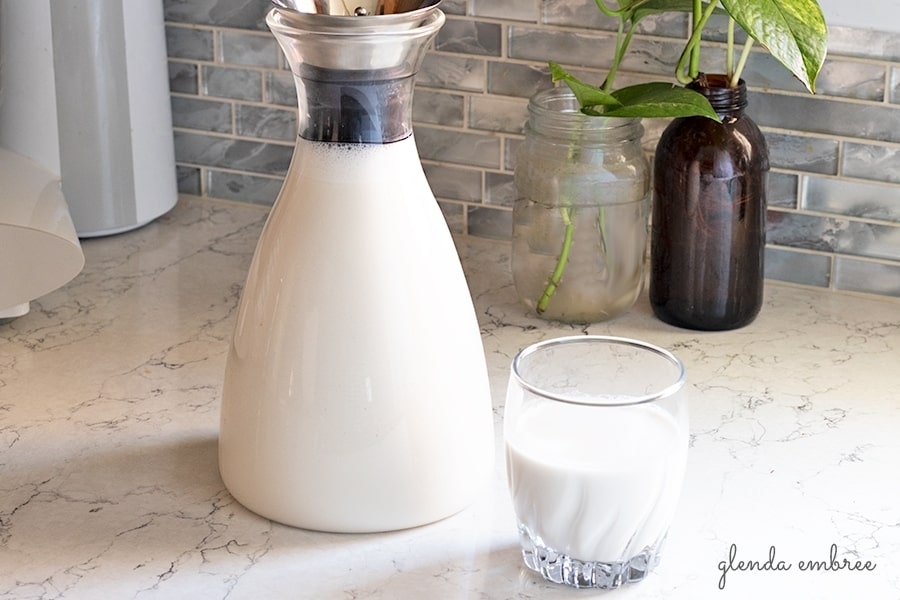
Cashew Coconut Milk is the dairy-free answer to our family’s struggle with milk. It is creamy and rich, with a naturally subtle sweetness. I’ve used it successfully in several recipes calling for milk (Think gravy, white sauce, soup and cake).
That’s the beauty of this fabulous dairy-free blend. You can cook with it! Plus, it tastes scrumptious on it’s own, it’s 3-ingredient simple and blends together in seconds, once the cashews and coconut are soaked.
We have always had one or two in our family that get uncomfortable when consuming cow’s milk or products made from it. It seems that lately, the numbers in that lactose intolerant group are growing and it just makes sense to have a delicious and healthful alternative on hand.
So, Cashew Coconut Milk is my answer when I want a really creamy and wonderful dairy-free milk alternative that can be heated. I substitute it 1:1 for dairy milk in any recipe. Plus it’s delicious on its own.
It’s a good source of extra protein, too. Take a look at this post at Sage Alpha Gal to learn more about high protein nuts.
If you or someone in your family is going dairy-free, this delicious dairy-alternative milk may be your answer, too.

Why Make Your Own Non-Dairy Blend?
There are a plethora of dairy-free milk alternatives available commercially. So, you might be wondering why I would bother to make my own.
Firstly, those ingredients. Turn over a carton of oat milk, almond milk or any other non-dairy variety, and you might be surprised to find the main ingredient is water. Why pay so much for mostly water?
Most will have added gums and preservatives. Some will have lecithins or other texture enhancers and many will have added salt and sugar. One of the most popular oat milks uses a large percentage of a not-so-healthy oil to achieve the fat levels that will allow their milk to froth when heated.
You can do better. This Cashew Coconut Milk is my answer.
Interestingly, you don’t taste the coconut. However, the cashew coconut combination provides enough of those healthy fats to create a sublimely creamy texture. And if you shake the jar, it definitely froths a bit!
Making my own just makes sense.
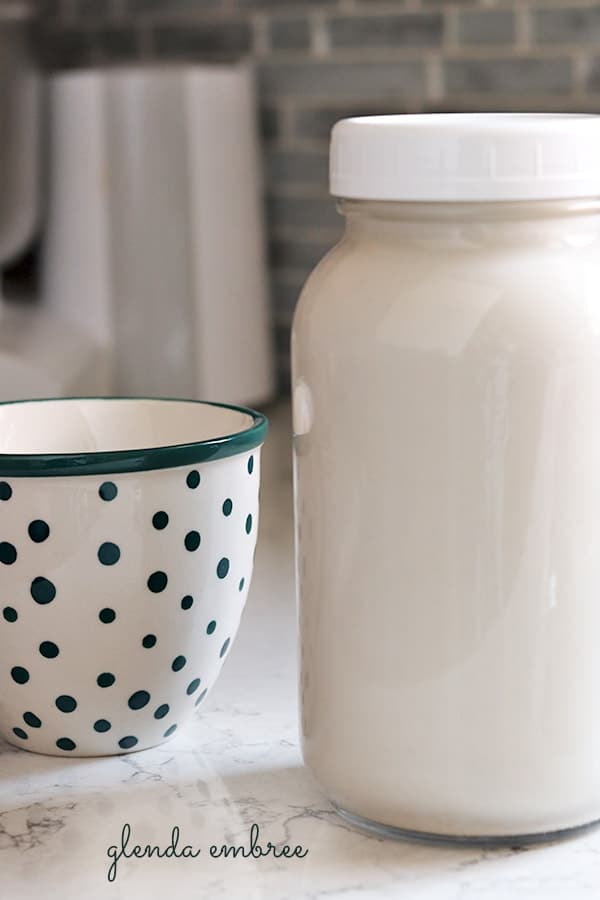
3 Simple Ingredients and Costs
- Raw Cashews [affiliate link] – Raw is important. Not toasted. Not salted. You may have an alternate source, but it’s so simple for me to just order these on Amazon. I get them 5 lbs at a time, so they last awhile. (I keep them in the freezer.) They cost me about $2.30 per cup.
- Unsweetened Coconut Flakes/Chips [affiliate link] – Again, I order these on Amazon. It ends up costing me about $1.25 per cup. You could probably use unsweetened shredded coconut, too, but the measurements would be different since the chips/flakes are so much larger. I haven’t tried using shreds.
- water
That brings my cost for a quart of Cashew Coconut Milk to $3.55 per quart. When I tried to compare that to commercial brands there weren’t many with the creamy cashew-coconut combination. And when I did find a couple, they were much more expensive (about double) and contained a ton of additives.
If I look at plain cashew milk, most of the products are more expensive than my homemade version or at about the same price. And, at the very least, all of them have added sugar and salt. Most had added gums and soybean lecithin. Some even added other varieties of nuts, (most notably, almonds) even though they sold the product as cashew milk.
For me the costs and ingredients add up to perfect when I’m making my Cashew Coconut Milk at home. I think you’ll agree when you give this simple 3-ingredient recipe a try.
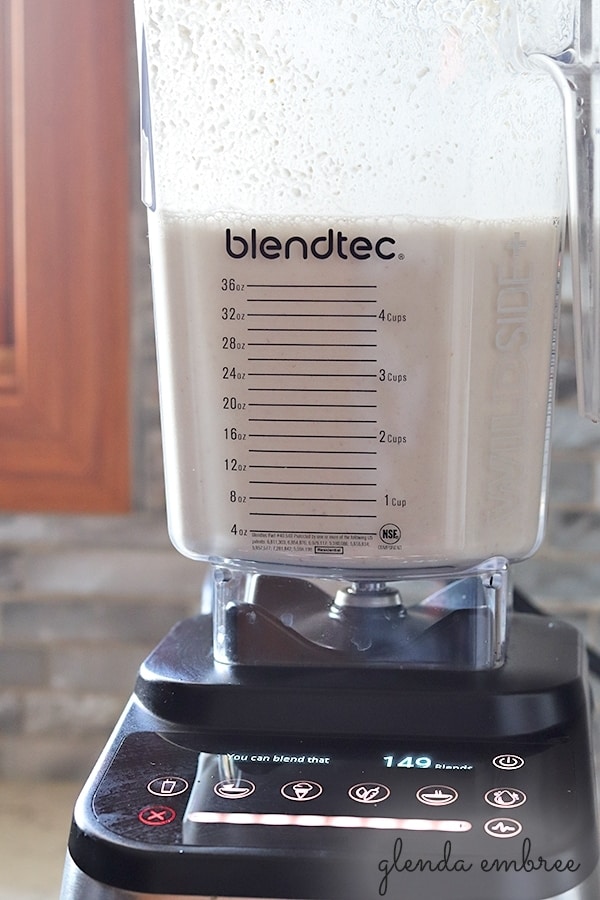
Tools for Making Coconut Cashew Milk
- High Speed Blender [affiliate link] – I usually use my *Blendtec [affiliate link] , but have also used the *Ninja iQ blender [affiliate link] . Any high-speed blender should do fine. Your milk will only be as good as your blender, essentially. To get the ultra-smooth, creamy texture you’re looking for a regular blender probably doesn’t have the needed power.
- Strainer [affiliate link]
- Ultra Fine Cheesecloth [affiliate link] or Butter Muslin [affiliate link] – These are basically the same thing, but butter muslin typically has a finer mesh. The names are used interchangeably sometimes though, so just be sure you purchase unbleached and a fine weave/mesh. Either can be washed by hand and re-used over and over.
- Large Bowl [affiliate link] – Any large bowl will work, but I love using my batter bowl for this. It has a pour spout that makes it so simple to pour the strained milk into my containers.
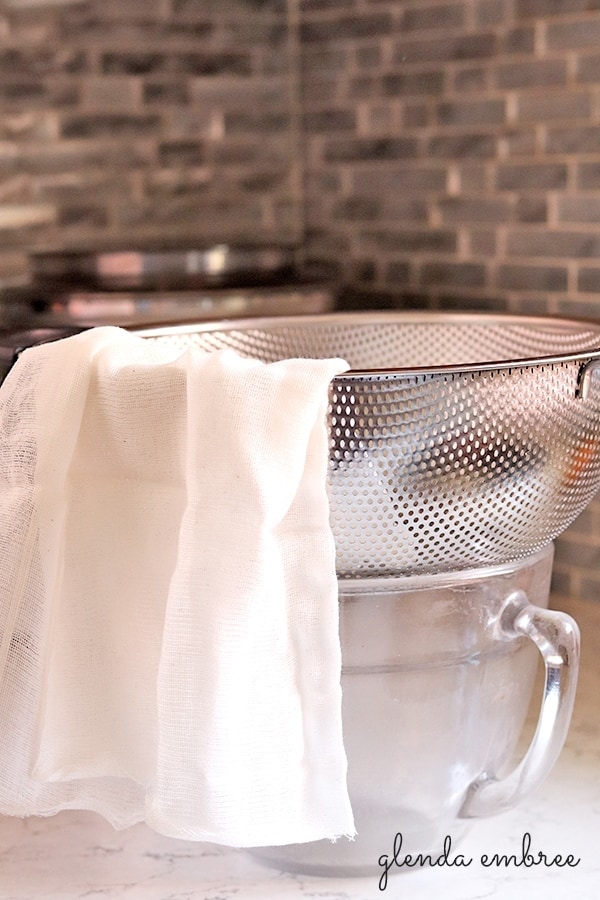
How to Make Cashew Coconut Milk
Step 1: Pour water over the cashews and coconut and give them a good soak. Make sure everything is submerged or at least floating. Allow them to soak for at least 12 hours. I usually start them soaking at suppertime and then they’re ready to go in the morning.
The longer soaking time results in smoother, creamier milk. A longer soak releases enzymes from the cashews that bump up the nutritional value. By fully hydrating the cashews and coconut they become softer and easier to blend, too.
Step 2: Drain the cashews and coconut after their 12 hour soak.
Step 3: Place the drained cashews, coconut chips/flakes and water into a high speed blender. Blend until the mixture becomes smooth and creamy with no evidence of the cashews or coconut in sight. It will probably be a little frothy or foamy on top. That’s normal.
Straining Cashew Coconut Milk
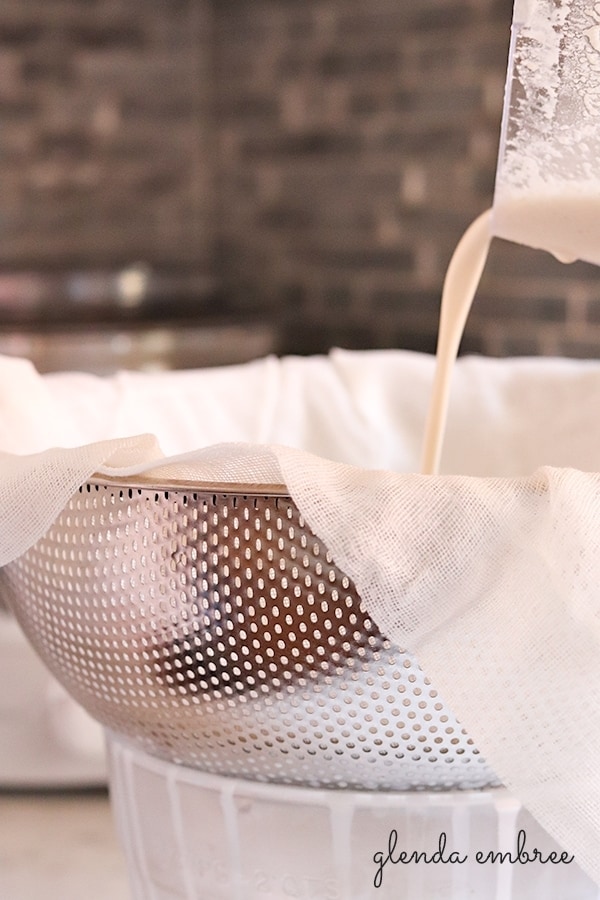
Step 4: Once your Cashew Coconut Milk is fully blended, place a strainer over a large bowl. Add a layer of butter muslin inside the strainer. I usually make a double layer to be sure I get the smoothest, creamiest milk.
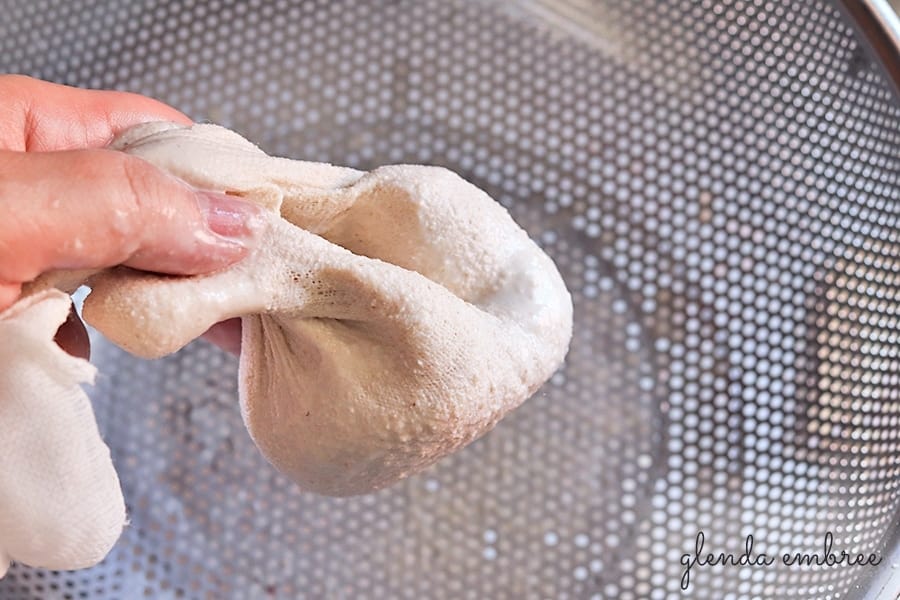
Step 5: Pour the blended mixture into the strainer. As the pulp is being filtered out of your milk, it may plug the tiny mesh of the cloth. I use a spoon to gently move it off the bottom of the cloth/strainer and allow the milk to run through more easily. When almost all the milk has drained through the strainer, I pick the cloth up by the edges and twist it closed. Then, I squeeze the last drips of milk out of the makeshift “bag”. All that will remain in the cloth is the dry pulp. I usually end up with about 1 cup. Save the pulp in a covered container in the fridge, for up to a week. It can be added to the recipe when making homemade granola or gluten-free crackers. I found a whole page of recipe ideas using nut milk pulp when I did a search.
Step 6: Pour the creamy delicious Cashew Coconut Milk from your bowl into a container for storing in the fridge. We have kept this milk in the fridge for up to a week, with no issues. We usually use it before then, though. I often make two batches to get us through a week, especially if I’m cooking with it.
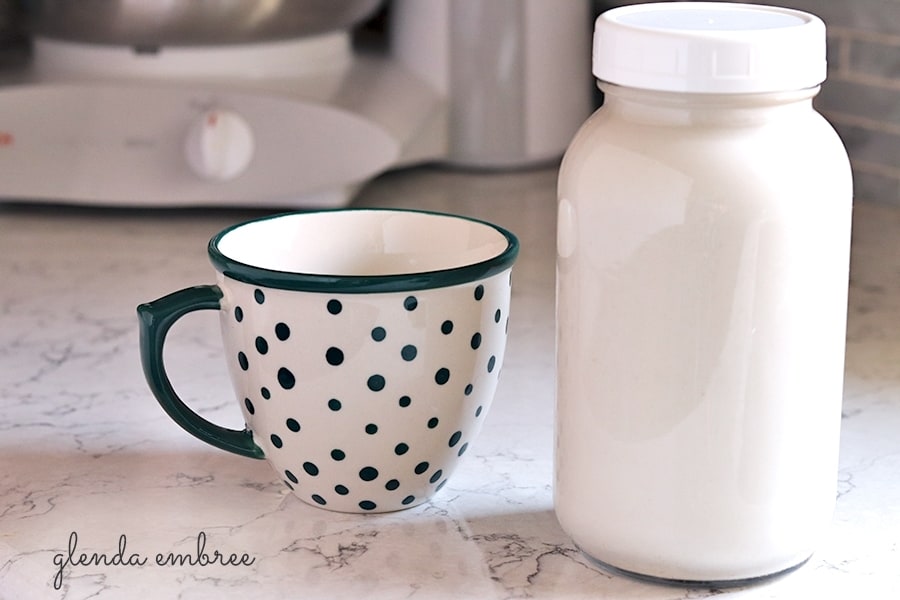
Want to Save This Recipe?
Enter your email & I’ll send you the link so you always have it at your fingertips. Plus, I’ll send a collection of easy recipes to your inbox every Friday!
By submitting this form, you consent to receive emails from Glenda Embree.

Cashew Coconut Milk
- Total Time: 12 hours 10 minutes
- Yield: 4 – 5 cups 1x
- Diet: Gluten Free
Description
Creamy, delicious dairy milk alternative that the whole family will love. It’s so simple, plus you control the ingredients and it’s more economical than commercial brands.
Ingredients
- 1 cup raw cashews
- 1 cup coconut flakes/chips
- 4 cups water
Instructions
- Place the cashews and coconut in a container large enough to cover them with water. Pour water over them until they are fully covered. Place plastic wrap over the container and leave to soak for at least 12 hours.
- After 12 hours, drain the cashews and coconut.
- Put the drained cashews and coconut in a high speed blender with 4 cups of water and blend until smooth and creamy. Blend long enough that you can see nothing but liquid.
- Place a strainer over a large bowl and line it with a double layer of butter muslin or fine-mesh cheesecloth.
- Pour the blended Cashew Coconut Milk into the strainer and allow it to drain through into the bowl. If the pulp begins to slow the draining, use a spoon to gently scrape it away from the bottom of the strainer and let the milk flow freely.
- Gather the edges of the straining cloth together and twist it to squeeze the last drips of milk from the pulp.
- Put the pulp in a covered container in the fridge for up to a week. Leftover pulp can be used in homemade granola, in cracker and bread recipes or even stirred into yogurt. I’ve hear of using about 1/4 cup in muffin recipes, too, though I haven’t tried it yet, myself.
- Pour the strained milk from the large bowl into a pitcher or jar and store in the fridge for up to one week.
- Use Coconut Cashew Milk as you would dairy milk.
- Prep Time: 12 hours 10 min
- Category: Beverage, Nut Milk, Dairy Alternative
- Method: Blender
- Cuisine: American

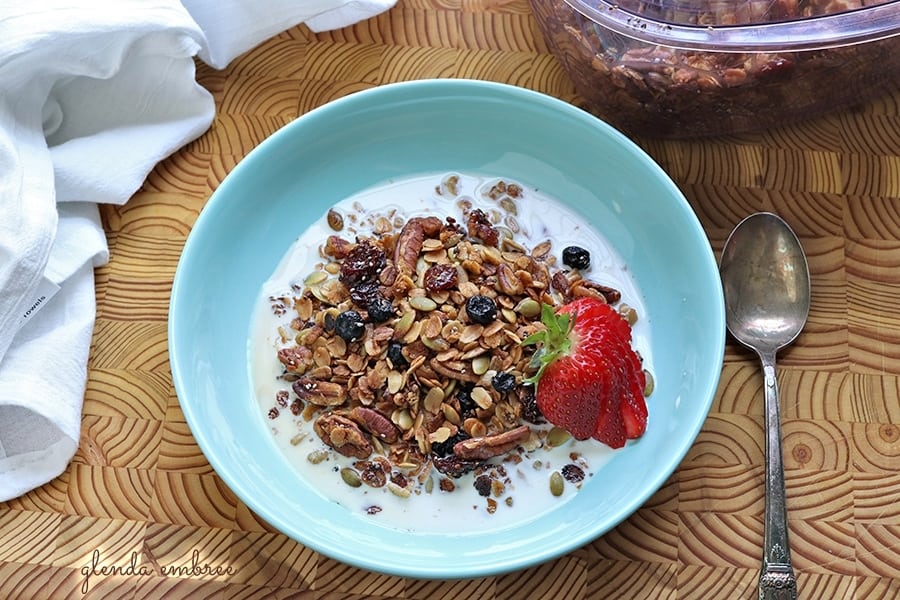
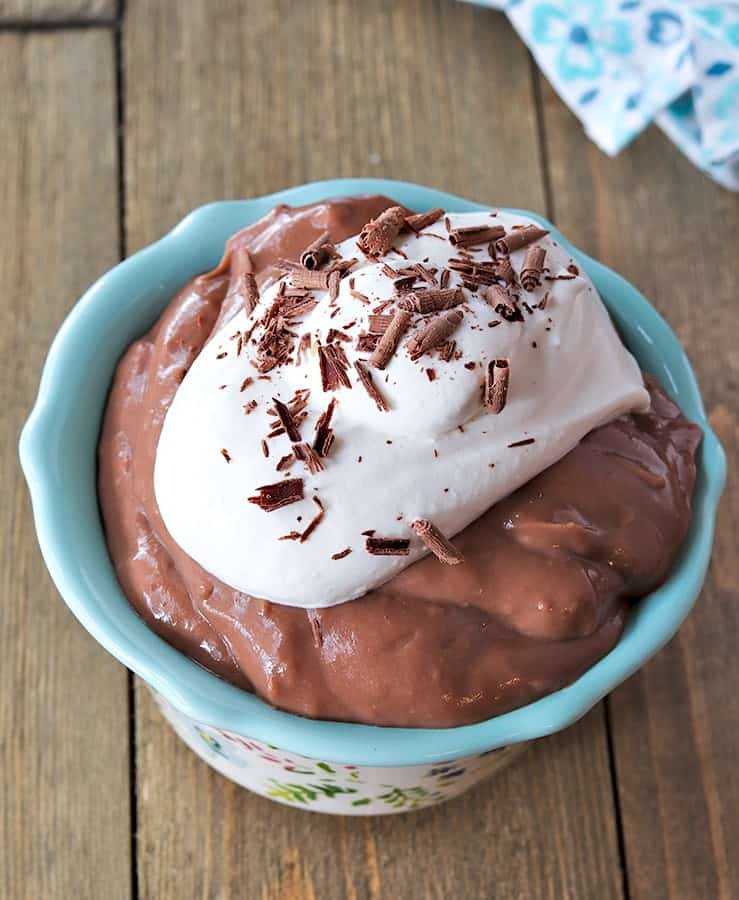
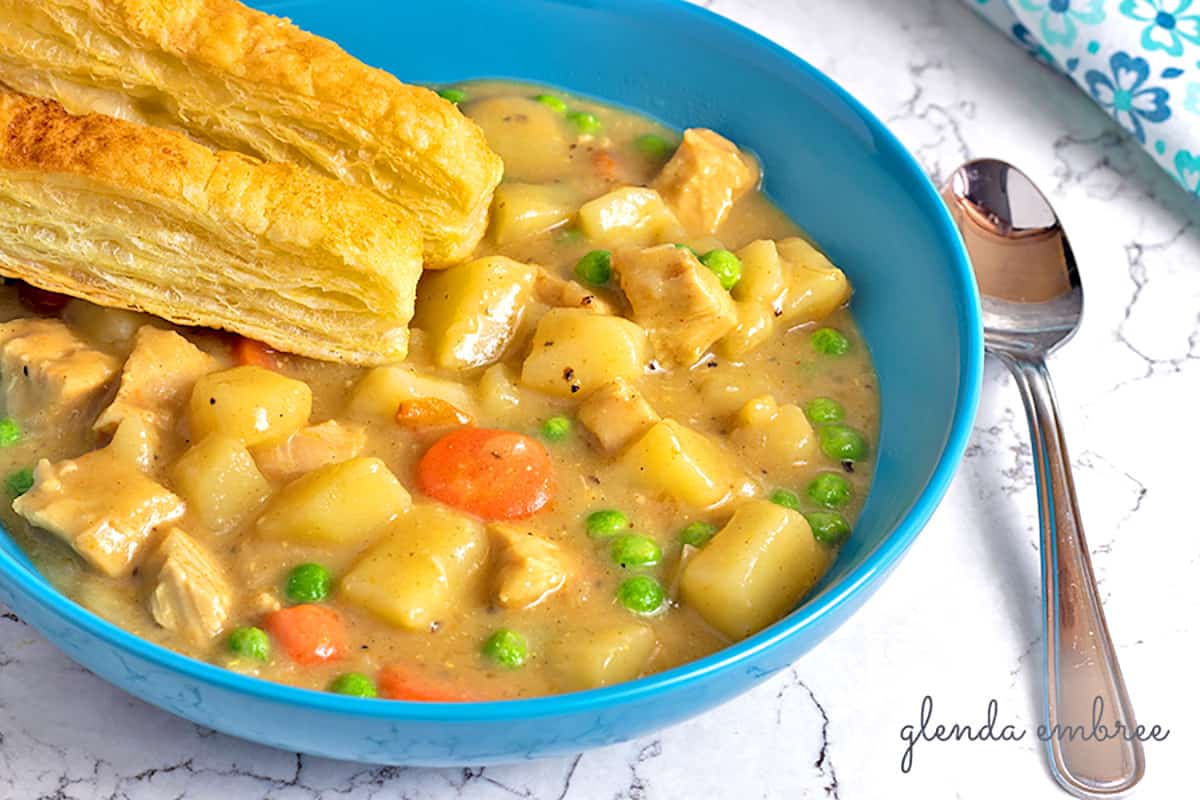


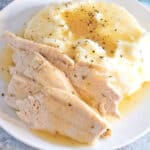







I’ve tried making different versions of plant base milk and this one is creamy and taste great!!! Thanks for the recipe, this will be on repeat at my house.
BH, I’m so happy you’re enjoying it!
I haven’t tried this yet, but look forward to trying it soon. It’s exactly what I was looking for. One quick question, would it make any sense to just use canned coconut milk with the cashew milk? Also, do you have Amazon links for the ingredients or the butter muslin cloth?
Hi Faith! I haven’t tried it with coconut milk, but I don’t know why it wouldn’t work to replace the coconut with that. I would reduce the water to 3 cups and then add 1 cups of coconut milk instead of the coconut flakes. The butter muslin I use is https://amzn.to/3L28pQA [affiliate link].
Hi Glenda. Is there a reason you strain the soaked nuts rather than just using that liquid in the milk? E.g. soak them in 6 cups overnight, then throw all of that in the blender in the morning?
Hi Tom! That’s a great question. Beyond softening the cashews, I was taught that the soaking allows the removal of phytic acid and enzyme inhibitors which makes the cashews (and most nuts and seeds) easier for us to digest. I’ve always felt that if I used the same water, I would be reintroducing those back into my recipe. So, I soak, drain and rinse. Then I use fresh water for the milk.